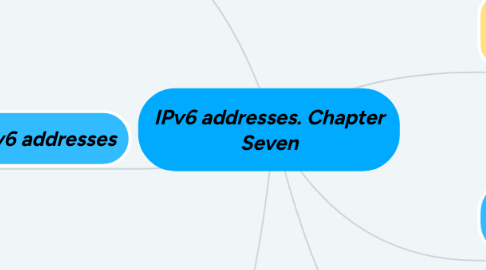
1. Rules
1.1. Rule 1
1.1.1. The first rule to help reduce the notation of IPv6 addresses is to omit the 0.
1.2. Rule 2
1.2.1. The second rule that reduces IPv6 address notation is that the two double points (: :).
2. Types of IPv6 addresses
2.1. Unicast
2.1.1. Uniquely identifies an interface of an IPv6 enabled device.
2.1.2. Global Unicast, Link-local, Single Local
2.2. Multicast
2.2.1. They are used to send a single IPv6 packet to several destinations.
2.2.2. Multicast assigned
2.2.2.1. For all nodes
2.2.2.1.1. FF02::1
2.2.2.2. For all nodes
2.2.2.2.1. FF02::2
2.2.3. Multicast of requested nodes
2.2.3.1. It is assigned to a special Ethernet multicast address.
2.3. Proximity Diffusion
2.3.1. It is any unicast IPv6 address that can be assigned to several devices.
3. Types of configurations.
3.1. DHCPv6
3.2. SLAAC
4. IPv6 has a larger 128-bit address space, which provides 340 sextillion addresses.
5. Coexistence of IPv4 and IPv6
5.1. Dual-stack
5.1.1. It allows IPv4 and IPv6 to coexist in the same network segment.
5.2. Tunneling
5.2.1. It allows IPv4 and IPv6 to coexist in the same network segment.
5.3. Translation
5.3.1. Communication between IPv4 and IPv6 through a translation technique similar to NAT for IPv4.
6. Link-Local Addresses
6.1. Dynamics
6.1.1. Created with the prefix FE80 :: / 10 and the interface ID using the EUI-64 process or a 64-bit random generation number.
6.2. Static
6.2.1. It is used so that it is possible to easily recognize that it belongs to router R1.
